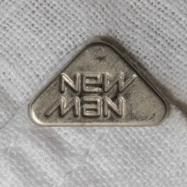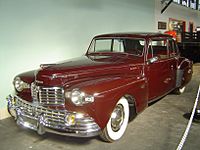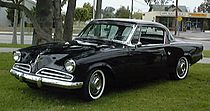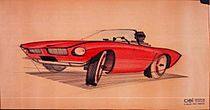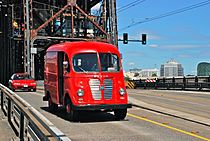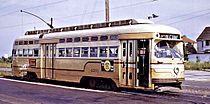Raymond Loewy facts for kids
Quick facts for kids
Raymond Loewy
|
|
|---|---|
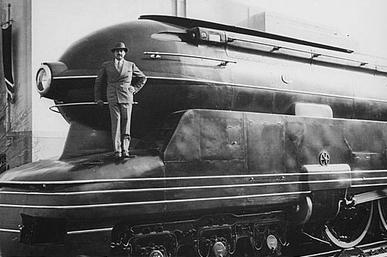
Loewy standing on one of his designs, the Pennsylvania Railroad's S1 steam locomotive
|
|
| Born | November 5, 1893 |
| Died | July 14, 1986 (aged 92) |
| Resting place | Rochefort-en-Yvelines Cemetery, Rambouillet, France |
| Citizenship | France, United States |
| Education | University of Paris |
| Occupation | Industrial Designer |
| Years active | 1909–1980 |
|
Notable work
|
|
| Spouse(s) | Jean Thompson Bienfait (m. 1931–1945; divorced) Viola Erickson (m. 1948–1986; his death) |
| Children | 1 |
Raymond Loewy ( LOH-ee November 5, 1893 – July 14, 1986) was a French-born American industrial designer. He became famous for creating the look of many everyday items. Time magazine even featured him on its cover in 1949.
Loewy spent most of his career in the United States. He became an American citizen in 1938. His designs include the logos for Shell, Exxon, TWA, and the former BP. He also designed the Greyhound Scenicruiser bus and helped redesign the Coca-Cola bottle.
Other famous designs include the Lucky Strike package, Coldspot refrigerators, and the Studebaker Avanti car. He also designed the look of Air Force One. People called him The Man Who Shaped America and The Father of Industrial Design.
Contents
Early Life and Education
Raymond Loewy was born in Paris, France, in 1893. His father, Maximilian Loewy, was a journalist. His mother was Marie Labalme.
Early Talents
Loewy showed his design skills early on. In 1908, he designed a successful model aircraft. It won the Gordon Bennett Cup for model airplanes. By 1909, he was selling his plane, called the Ayrel.
He finished his studies at the University of Paris in 1910. He also studied advanced engineering.
Military Service and Move to America
Loewy served in the French army during World War I (1914–1918). He became a captain and was wounded in battle. He received the Croix de guerre medal. After the war, in September 1919, he moved to New York City.
A Career in Design
In his early years in the United States, Loewy worked as a window designer. He created displays for big department stores like Macy's and Saks. He also drew fashion pictures for magazines like Vogue.
First Design Projects
In 1929, Loewy got his first big design job. He was asked to make a duplicating machine for Gestetner look more modern. More jobs followed, including work for Westinghouse. He also designed the look of the Coldspot refrigerator for Sears-Roebuck. This refrigerator design made him famous as an industrial designer. He even opened an office in London in the 1930s.
Designing for Railroads
In 1937, Loewy started working with the Pennsylvania Railroad. He designed the sleek, modern look for some of their locomotives. This included the S1 and T1 steam engines. He also improved the look of the famous GG1 electric locomotive. He made it look smoother and added a pinstripe design.
Loewy's team also designed train stations, passenger car interiors, and advertisements for the railroad. By 1949, his company had 143 designers working for him.
Studebaker Cars
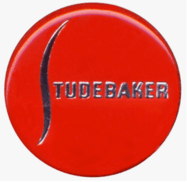
Loewy had a long partnership with the car maker Studebaker. He started working with them in 1936. He even designed a new logo for Studebaker.
During World War II, other car companies couldn't work on new car designs. But Loewy's company was independent. This allowed Studebaker to release the first all-new postwar car in 1947. This was two years before bigger car companies like Ford and General Motors. His team created a modern design with smooth lines.
Loewy's team also designed the "bullet-nosed" Studebakers of 1950 and 1951. They also created the 1953 Studebaker line, including the beautiful Starliner and Starlight coupes. These cars are still seen as some of the best-designed cars of the 1950s.
In 1961, Studebaker's new president asked Loewy to design the Avanti. Loewy had only 40 days to create the design. He gathered a team of designers, and they worked in a house in Palm Springs, California. The Avanti became a very unique and famous car.
Designing for NASA
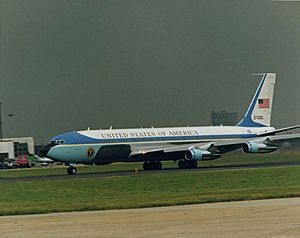
From 1967 to 1973, Raymond Loewy worked for NASA. He was a consultant for the Skylab space station. His job was to make the space station more comfortable and safe for astronauts.
Astronauts would spend a long time in a small space. Loewy wanted to improve their well-being. He suggested adding a "wardroom" where the crew could eat and work together. He also designed a window for the wardroom to allow views of Earth. He made sure each sleeping area had a different layout to give astronauts a sense of their own space. He even designed the dining table and how food would be eaten in space.
Farm Equipment and Other Designs
In 1935, the International Harvester company hired Loewy. They made farm machinery and construction equipment. Loewy was asked to redesign their entire product line, from the company's logo to how easy the machines were for operators to use. The first machine with his design was the International TD-18 tractor in 1938. His designers also helped Allis-Chalmers with their tractor designs.
Personal Life and Legacy
Raymond Loewy's first marriage ended in divorce. He later married Viola Erickson.
In 1980, Loewy retired at age 87 and moved back to France. He passed away in his home in Monte Carlo on July 14, 1986. He was buried in a cemetery in Rochefort-en-Yvelines, France. He was survived by his wife, Viola, and their daughter, Laurence.
The Raymond Loewy Foundation
In 1992, Loewy's wife Viola and daughter Laurence started the Raymond Loewy Foundation in Hamburg, Germany. The foundation helps keep Loewy's memory alive and promotes industrial design. They give an annual award of €50,000 to great designers.
Loewy's Design Idea
Loewy's daughter, Laurence, continued to manage her father's design interests. She worked to share his design philosophy, called MAYA. MAYA stands for "most advanced, yet acceptable." This means designs should be new and modern, but also easy for people to accept and use.
In 2013, on his birthday, Loewy was honored with a Google Doodle. It showed a streamlined train, similar to one of his famous designs.
Loewy Designs
|
Famous Designs
1900s
1920s
1930s
1940s
|
1950s
1960s
1970s
|
Gallery
-
A 1946 Lincoln Continental
-
1937 Thermos flask
-
Elna Lotus portable folding sewing machine
-
A Leisurama house in Montauk, New York; Leisurama houses could be purchased at Macy's department store
-
Union News coffee shop at the TWA Flight Center, Idlewild] Airport (JFK)
-
Air Force One with Loewy-designed livery
-
The USCG Racing Stripe logo (1964)
-
The Exxon logo, designed in 1966, introduced in 1972
Published Books
- The Locomotive: Its Aesthetics (1937) ISBN: 978-0876636763
- Never Leave Well Enough Alone (1951, autobiography) ISBN: 0-8018-7211-1
- Industrial Design (1979) ISBN: 0-87951-260-1
Images for kids
-
Union News coffee shop at the TWA Flight Center, Idlewild] Airport (JFK)
See also
 In Spanish: Raymond Loewy para niños
In Spanish: Raymond Loewy para niños


